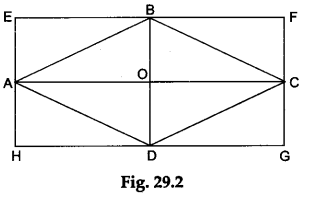Math Labs with Activity – Derive a Formula for Finding the Area of a Rhombus (Method 2)
OBJECTIVE
To derive a formula for finding the area of a rhombus (Method 2)
Materials Required
- A sheet of white paper
- A sheet of glazed paper
- A geometry box
- A pair of scissors
- A tube of glue
Theory
It has been geometrically proved that the area of a rhombus is given by area = ½ x product of its diagonals.
Procedure
Step 1: Construct any rhombus ABCD on a sheet of white paper. Draw its diagonals AC and BD intersecting at a point O as shown in Figure 29.1. Let d1 and d2 be the lengths of the diagonals AC and BD respectively.

Step 2: Draw lines EF and HG passing through the points B and D respectively and both parallel to the diagonal AC. Also, draw lines EH and FG passing through the points A and C respectively and both parallel to the diagonal BD. We thus obtain a rectangle EFGH as shown in Figure 29.2.

Step 3: Make an exact copy of the rhombus ABCD on the glazed paper. Draw diagonals AC and BD. Cut the four triangles AOB, BOC, COD and DOA. Paste these triangles in the rectangle EFGH outside the rhombus ABCD as shown in Figure 29.3.

Observations and Calculations
We observe that the portion of the rectangle EFGH which lies outside the rhombus ABCD is exactly covered by the four triangular parts of the rhombus ABCD.
∴ area of the rectangle EFGH = 2 x area of the rhombus ABCD
area of the rhombus ABCD =½ x area of the rectangle EFGH
= ½ x d1 x d2
Thus, area of the rhombus = ½ x product of its diagonals.
Result
The area of a rhombus is half the product of its diagonals.
Math Labs with ActivityMath LabsMath Lab ManualScience LabsScience Practical Skills
